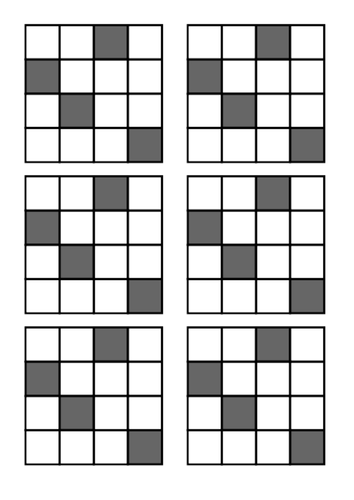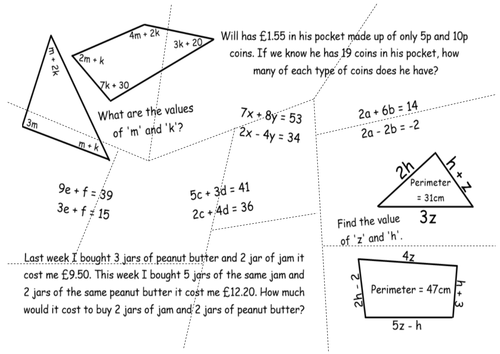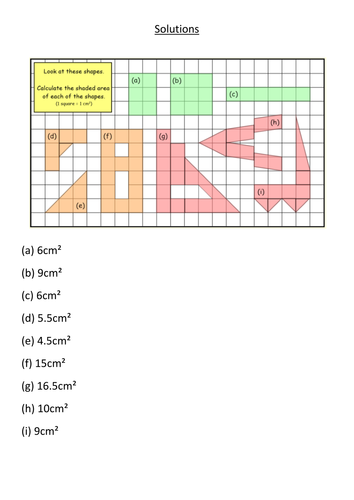87Uploads
297k+Views
261k+Downloads
All resources

Angles & Parallel Lines (Double Lesson)
This is a double lesson package and includes 2 lessons on angles and parallel lines. The first lesson looks at recalling the rules of angles formed when a transversal crosses parallel lines. The second lesson looks at applying these rules to find missing angles.
This lesson is appropriate for the full range of attainments. The lessons start by recapping prior knowledge before moving on to look at the new content. Pupils need a knowledge of basic geometry notation, angles on a straight line, around a point and in a triangle, quadrilateral and the angle properties of special triangles. This lesson allows the topic to be differentiated for a variety of attainment levels and could easily be adapted to meet the needs of higher or lower attaining groups through missing out specific examples.
As with all the angle lessons the Maths Market has available, challenge comes from increasing difficult application of rules and through the interleaving of previous learning on angles and through the involvement of forming and solving a variety of equations.
The lessons include;
Starters
Introduction to the topic in small chunks
Opportunities to practice basic skills through collaborative activities.
Examples and counterexamples
Clear modelling through “I do” and “You Do” examples.
Multiple choice questions to draw out misconceptions.
Differentiated worksheets.
Challenge questions.
The lesson includes the solutions and is fully animated which will make it perfect for delivering live remote lessons.

Volume of a Sphere
Here is a full lesson on calculating the volume of a sphere.
It contains an introduction, examples of a sphere and a hemisphere, a differentiated worksheet and a plenary.
All solutions are included on the slides.
Hope it helps and happy teaching.

Percentage Increase and Decrease (Multiplier Method)
Here is a full lesson on calculating a percentage increase and decrease using the multiplier method.
It recaps converting between decimals and percentages, it looks at using the multiplier method to find a percentage before moving onto percentage increases and decrease using the multiplier method.
It contains examples, questions, a true or false activity, a differentiated worksheet, a plenary and all solutions are included on the slides.
Hope it helps and I hope you enjoy teaching it!

Areas of Compound Shapes Made From Rectangles
Here is a full lesson on calculating the areas of compound shapes made from rectangles.
The lesson contains examples, spot the error task, a differentiated worksheet.
All answers included on the slides.
Hope it helps and have fun teaching!

Pythagoras' Theorem - Finding the hypotenuse
Here is a full lesson which introduces Pythagoras’ Theorem and then looks at applying it to find the hypotenuse in a right angled triangle.
It includes an introduction, a little history, some examples, a differentiated worksheet, plenary and the solutions are included on the slides.
Hope it helps and happy teaching!

Plotting Co-ordinates
Nice lesson on plotting co-ordinates takes pupils through from the basics. It includes 1 quadrant and all 4 quadrants.
There are a couple of really nice activities such as the one where you hide co-ordinates around the room and pupils have to find them to crack the code. Also, there is a bingo towards the end based on Christmas presents and co-ordinates.

Nets and Properties of 3D shapes
A full lesson looking at some key properties and vocabulary of 3 shapes.
It contains a link to a geogebra file.

Patterns and Sequences
A full lesson on sequences and patterns.
It start by looking at finding missing terms, moves on to the nth term of a sequence before moving on to applying nth term algebra to problems involving pictures.

Angles in a Triangle
This lesson covers the full range of attainments for missing angles in a triangle. It starts by recapping prior knowledge on angles on a straight line and around a point before moving onto the basics of angles in a triangle. This lesson allows the topic to be differentiated for a variety of attainment levels and could easily be adapted to meet the need of higher or lower attaining groups through missing out specific examples.
The lesson does not look at the specific angle properties of isosceles and equilateral triangles, however, I do have a lesson on this available. This lesson spends time really allowing students to build an understanding of angles in a triangle and build change though the interleaving of previous learning on angles and through the involvement of forming and solving a variety of equations.
The lesson includes;
Starter
Introduction to the topic in small chunks
Opportunities to practice basic skills through a collaborative activity.
Clear modelling through “I do” and “You Do” examples.
Multiple choice questions to draw out misconceptions.
Differentiated worksheet.
A challenge question.
The lesson includes the solutions and is fully animated which will make it perfect for delivering live remote lessons.

Angle Properties of Special Quadrilaterals
This lesson covers the full range of attainments on the angle properties of special quadrilaterals. It starts by recapping prior knowledge on angles on a straight line, around a point, angles in a triangle, angles and parallel lines and basic angles in quadrilateral before moving onto the angle properties of a variety of triangles. This lesson allows the topic to be differentiated for a variety of attainment levels and could easily be adapted to meet the needs of higher or lower attaining groups through missing out specific examples.
The lesson focuses on the angle properties of trapeziums, kites, parallelograms and rhombuses. If this is the first lesson looking at angles in a quadrilateral I recommend you spend a lesson first looking at basic angle facts in a quadrilateral. I do have a lesson on this available.
This lesson spends time really allowing students to build an understanding of angle properties in a trapezium, a kite, a parallelogram and a rhombus. Challenge comes through interleaving of previous learning on angles and through the involvement of forming and solving a variety of equations.
The lesson includes;
Starter
Introduction to the topic in small chunks
Recapping of prior knowledge
Opportunities to practice basic skills through a collaborative activity.
Clear modelling through “I do” and “You Do” examples.
Multiple choice questions to draw out misconceptions.
Differentiated worksheet.
A challenge question.
The lesson includes the solutions and is fully animated which will make it perfect for delivering live remote lessons.

Interior Angles in a Polygon
Here is a full lesson on finding the sum of interior angles in a polygon.
The lesson looks at what a polygon is, then finding the sum of interior angles through breaking into triangles then using the sum of interior angles to find a missing angle.
It contains examples, a differentiated worksheet and answers included on the slides.
Hope it helps and have fun teaching!

Angles in a Quadrilateral
This lesson covers the full range of attainments for missing angles in a quadrilateral. It starts by recapping prior knowledge on angles on a straight line, around a point and in a triangle before moving onto the basics of angles in a quadrilateral. This lesson allows the topic to be differentiated for a variety of attainment levels and could easily be adapted to meet the needs of higher or lower attaining groups through missing out specific examples.
The lesson does not look at the specific angle properties of kites, trapeziums, parallelograms and rhombuses, however, I do have a lesson on this available. This lesson spends time really allowing students to build an understanding of angles in a quadrilateral and builds change though the interleaving of previous learning on angles and through the involvement of forming and solving a variety of equations.
The lesson includes;
Starter
Introduction to the topic in small chunks
Opportunities to practice basic skills through a collaborative activity.
Clear modelling through “I do” and “You Do” examples.
Multiple choice questions to draw out misconceptions.
Differentiated worksheet.
A challenge question.
The lesson includes the solutions and is fully animated which will make it perfect for delivering live remote lessons.

Missing Angle on a Straight Line
This lesson covers the full range on attainments for missing angles on a straight line. It starts with the basics before moving on to forming and solving equations involving angles on a straight line.
The lesson includes;
Starter
Introduction to the topic in small chunks
The use of examples and non-examples to address misconceptions
Clear modelling through “I do” and “You Do” examples.
Multiple choice questions to draw out misconceptions.
Differentiated worksheet.
The lesson includes the solutions and is fully animated which will make it perfect for delivering remote lessons.

Angle Properties of Special Triangles
This lesson covers the full range of attainments on the angle properties of special triangles. It starts by recapping prior knowledge on angles on a straight line, around a point and basic angles in triangles before moving onto the angle properties of a variety of triangles. This lesson allows the topic to be differentiated for a variety of attainment levels and could easily be adapted to meet the needs of higher or lower attaining groups through missing out specific examples.
The lesson focuses on the angle properties of isosceles and equilateral triangles. If this is the first lesson looking at angles in a triangle I recommend you spend a lesson first looking at basic angle facts in a triangle. I do have a lesson on this available.
This lesson spends time really allowing students to build an understanding of angle properties of isosceles and equilateral triangles. Challenge comes through interleaving of previous learning on angles and through the involvement of forming and solving a variety of equations.
The lesson includes;
Starter
Introduction to the topic in small chunks
Recapping of prior knowledge
Opportunities to practice basic skills through a collaborative activity.
Clear modelling through “I do” and “You Do” examples.
Multiple choice questions to draw out misconceptions.
Differentiated worksheet.
A challenge question.
The lesson includes the solutions and is fully animated which will make it perfect for delivering live remote lessons.

Calculating Volumes of Prisms
A top quality lesson on finding the volume of a prism!
The lesson contains a variety of different activities including a bingo game, a connect 4, a differentiated worksheet and a whole class game.
All solutions are included along with all printable resources and a learning plan.
As always an unrivalled quality of IWB with teacher hints included (these need deleting before you use it) that should allow you to make the most of this lesson.
Hope you and your pupils enjoy the lesson.

Missing Angles Around a Point
This lesson covers the full range on attainments for missing angles around a straight line. It starts by recapping prior knowledge on angles on a straight line before moving onto the basics of angles around a point. Before the lesson builds to forming and solving equations involving angles around a point.
The lesson includes;
Starter
Introduction to the topic in small chunks
The use of examples and non-examples to address misconceptions
Clear modelling through “I do” and “You Do” examples.
Multiple choice questions to draw out misconceptions.
Differentiated worksheet.
The lesson includes the solutions and is fully animated which will make it perfect for delivering remote lessons.

Multiplying by Powers of 10
Here is a full lesson on multiplying by powers of 10.
It contains examples which explain what we do both visually and the rules.
It contains a game and differentiate questions.
All answers are included.
Hope it helps and happy teaching.

Dividing by Powers of 10
Here is a full lesson on dividing by powers of 10.
It contains an introduction, a division snake, a connect 4 game, a visual representation for dividing by powers of 10 with rules and examples.
It contains differentiated questions. All solutions included on the slides.
Hope it helps and happy teaching.

Solving Simultaneous Equations
A great lesson on solving simultaneous equations using elimination.
It contains a variety of examples with differentiated questions, a jigsaw puzzle and a team game towards the end which the pupils loved. It includes both worded questions and standard algebraic questions.
I have included teacher hints on each slide to help you find the hidden tabs on the IWB. Please delete these out before you use it in the classroom.
All the solutions are included!
Enjoy :-)

Finding Areas of Compound Shapes
This is a complete lesson on calculating the area of compound shapes.
It is a great introduction to compound area starting by looking at counting squares before moving onto rectangles and triangles before then compound areas.
It also contains a nice thoughts and crosses activity on area and a fantastic functional problem.




















